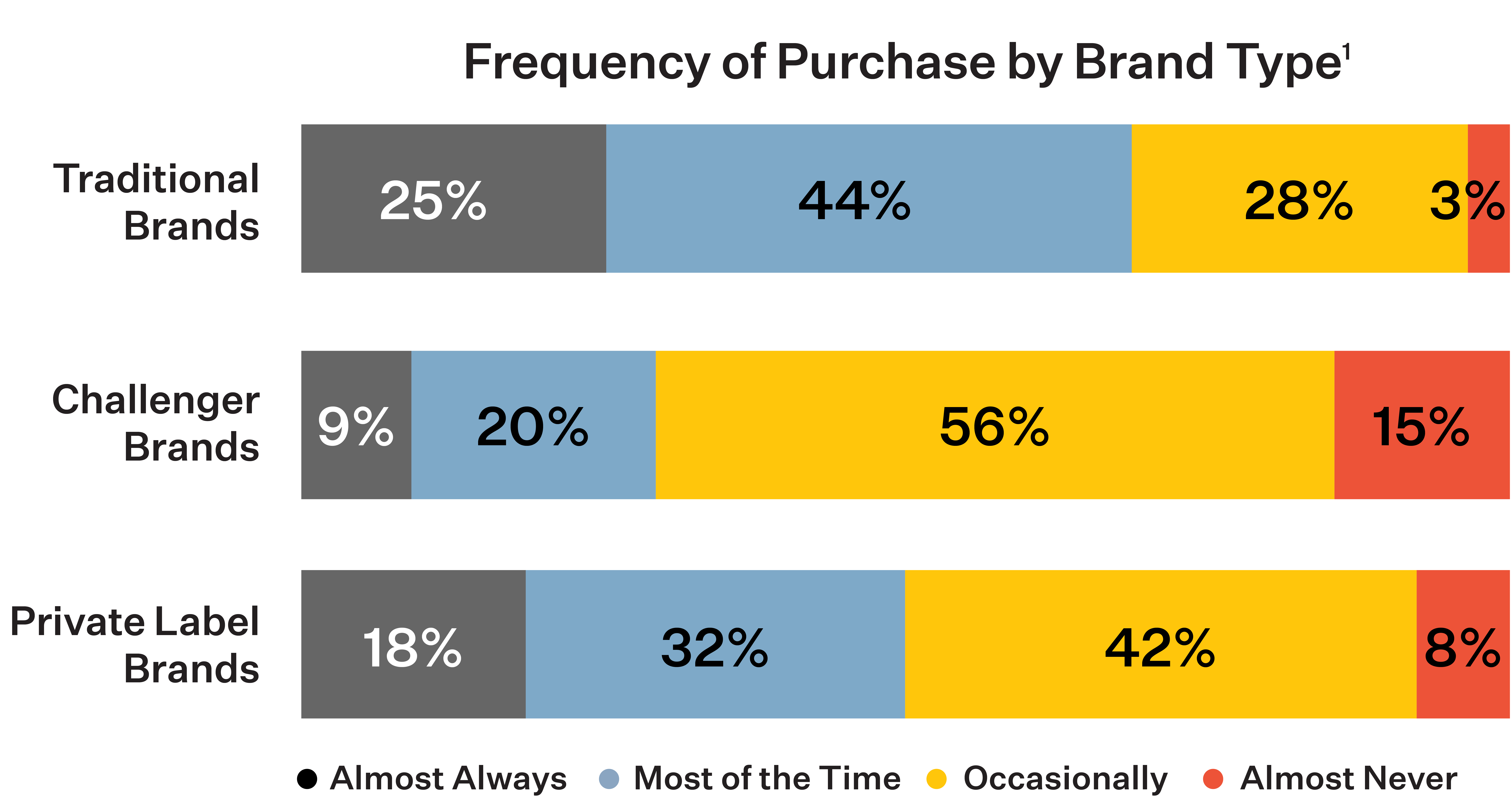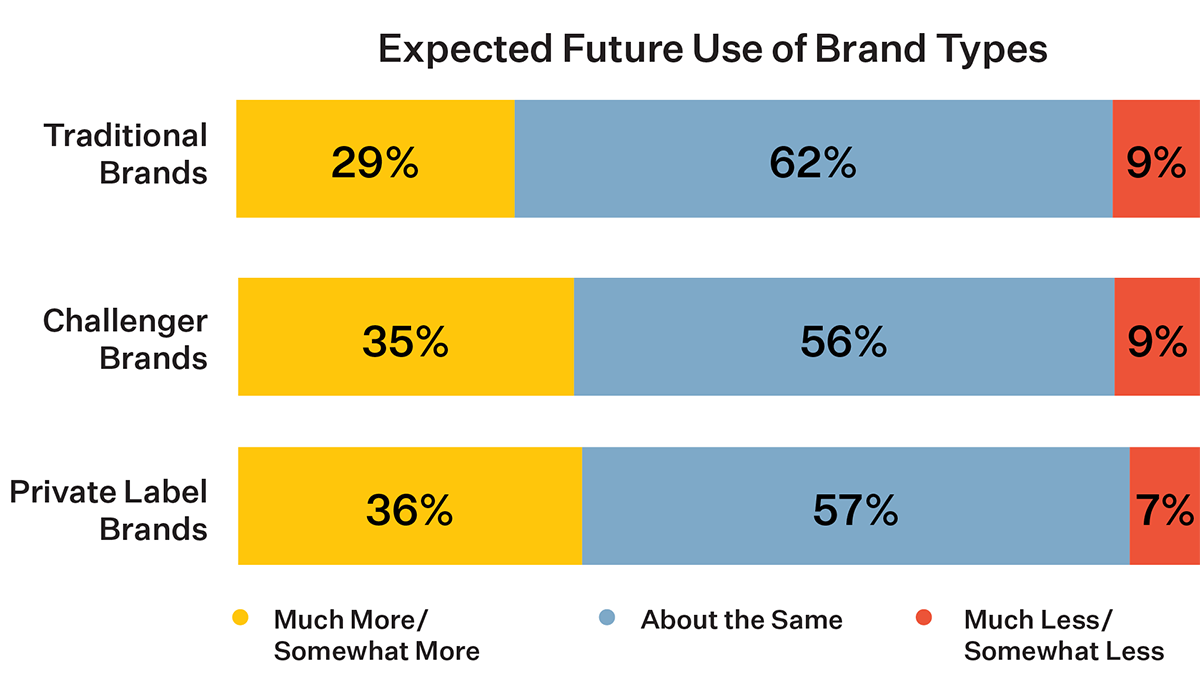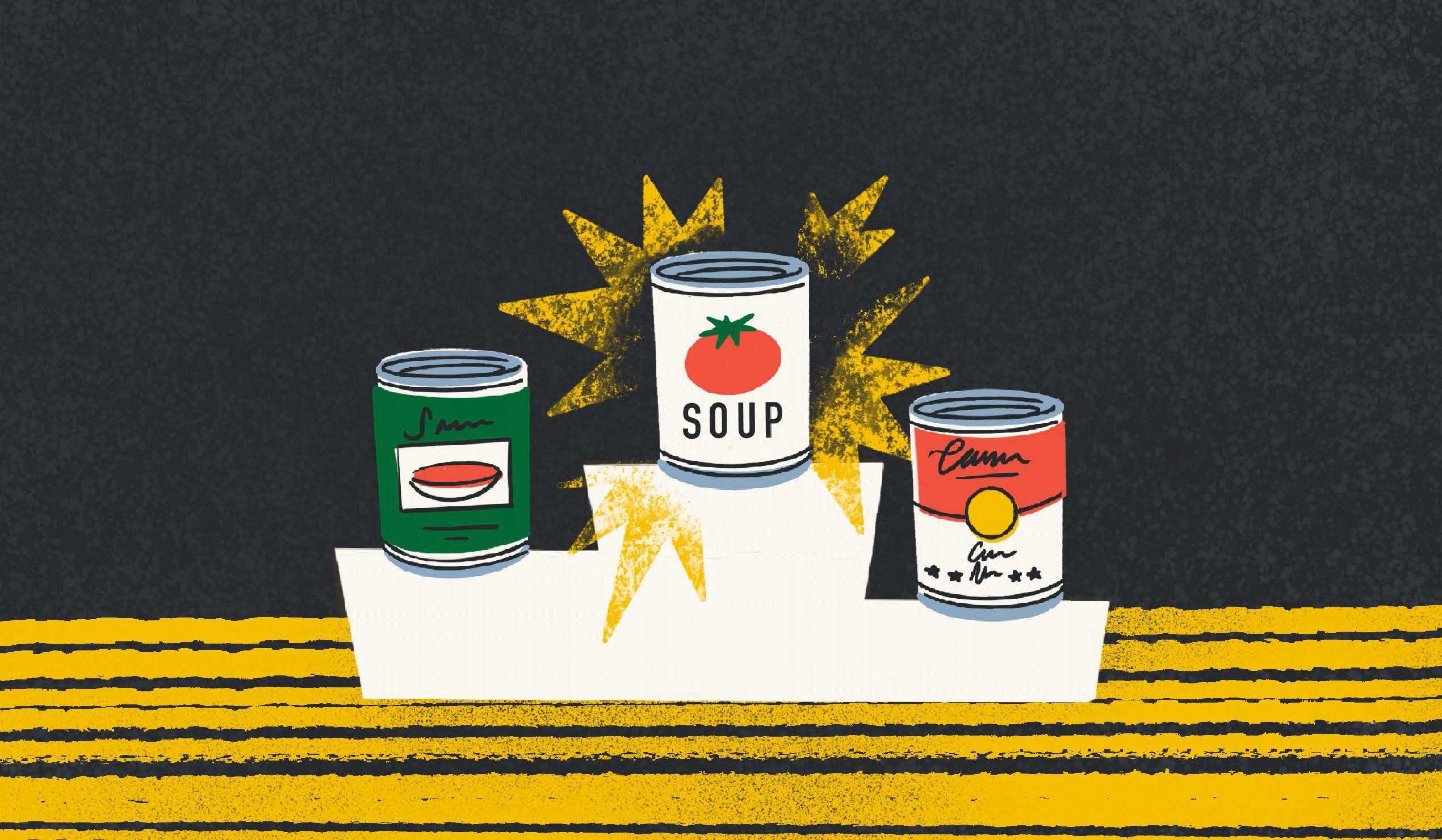The latest FoodThink white paper closely examines the rise of challenger brands – those small, up-and-coming companies stealing both revenue and market share from larger, more traditional food brands.
Successful challengers are forcing traditional brands to react – addressing weaknesses (like investing in a credible social media strategy and responding more directly and authentically to customer feedback) and going on the offensive when necessary (such as purchasing challenger brands altogether).
At the same time, big brands and challengers alike need to continuously monitor private label brands – also known as store brands – which have made consistent inroads in terms of revenue and reputation.
Because private labels and challenger brands are smaller than traditional brands and function with fewer operational and marketing resources, it can be tempting to lump them together. But their unique qualities demand we distinguish the two – not just in this post but within all FoodThink research and the resulting “Challenger Brands” white paper.
Looking back at private labels
In the past, private label foods didn’t enjoy a stellar reputation. Being known colloquially as “knock-offs” never helped their case, and bland packaging and little to no marketing further cemented the idea of lesser quality in the minds of consumers.
Private labels had their place, though, and served a specific purpose. Young adults, lower-income families and other cost-conscious shoppers purchased these brands to save money. Accordingly, private labels were more often bought out of necessity than aspiration.
But as you’ll learn within this post, things have changed. Private labels adapted to market shifts and continue to do so.
Who buys store brands today?
Fifty percent of consumers say they purchase private labels almost always or most of the time. This falls between traditional brands (69%) and challenger brands (29%), demonstrating the importance of private labels in today’s marketplace.1

Consumers continue to report buying traditional brands more prevalently today, but when projecting future purchase behavior, 36% say they plan to ramp up their private label brand purchases. Fifty-seven percent anticipate their private label purchases will remain about the same.1

Along with challenger brands, private labels are a favorite among “early adopters,” consumers quick to embrace a brand when it first launches. Early adopters used to represent a small, early niche segment of the market, but current FoodThink data finds that 34% of consumers consider themselves early adopters.1
Early adopters are more likely to be educated millennials with a high income ($75K and higher) and working full time. Now the largest generational population in the U.S.,2 millennials will likely be contributing to the trend of more consumers perceiving themselves to be early adopters.
In line with that shift, lower-income consumers (those making less than $50K) did not report to be more likely to buy private label foods than those with moderate or high incomes. Demographically speaking, private label purchasers are instead more likely to be younger and have a middle income and kids at home than the general population.1
The “Challenger Brands” white paper dives further into demographic purchase habits, gauging responses based on age, education, children, employment and income levels.
The private label paradigm is shifting
Retailers have worked hard in recent years to shed private labels’ lowly reputation, slowly yet steadily taking on both big brands and challenger brands in product quality and marketing sophistication.
It’s working. Seventy-four percent of FoodThink survey respondents agree the quality of store food brands has improved in recent years, and 70% agree the quality of store food brands is just as good as that of national brands.1
As perception has improved, so too have sales.
According to eMarketer, private label sales are on the rise at premium grocery stores and large retailers. Grocery titans such as Kroger, Target and Albertsons are rethinking their private labels to enhance their prestige, with one such strategy emphasizing plant-based and premium-branded offerings.3
In August 2019, Target launched its Good & Gather brand. The private label features a product line of organic foods as well as a “signature” line of premium products. Eventually, Good & Gather will replace the retailer’s long-serving Archer Farms and Simply Balanced brands.3
Target isn’t alone in its quest to revamp its private label offerings. Food retailers all over the country are working to make their own brands – perhaps more aptly described as bottom-line assets – more attractive to shoppers who may otherwise select traditional or challenger brands.
Retailers do have the upper hand in a couple of important areas, according to Retail Dive.
- They can run loyalty programs that reward customers for purchasing private labels. These programs also help stores collect valuable shopper data that may not be available to other brands.4
- They control their own shelf and display space. Barring contractual obligations with distributor brands, retailers can reserve the best placements for their own brands.4
Overall, private label sales have grown three times faster than sales of national brands, and Nielsen projects that the private label share could hit 25% by 2027.5
What can private label brands teach us?
Just like with challenger brands, store brands’ strategic leverage will only grow stronger in the market. Here are a few strategic implications:
- For retailers with private labels: Continue to invest in growing private label sales. All signs point to continued growth in share, and there’s a lucrative market for you in terms of both revenue and reputation. A word of caution, however. This will require more than just adding products and shelf space. It will take a thoughtful brand strategy and investment that will counter the response of larger, more traditional brands.
- For retailers without private labels: Examine the viability of a private label extension strategy. Countless retailers can verify their increasing merit, and not just among value shoppers. Many successful private labels, such as Archer Farms and Costco’s Kirkland, have become so popular that shoppers often don’t even realize they aren’t national brands. Research your audience’s shopping behavior and any feedback they’ve provided. Are they looking for greater value AND quality? Is there equity in your retail brand that can translate to products on the shelf?
- For traditional brands: While challenger brands are an obvious threat and the main focus of our latest white paper, private labels cannot be ignored. Treat private labels as seriously as you would any branded competitor. If you haven’t already, update your strategic plan to reflect them as a legitimate competitive threat.
- For challenger brands: Private label brands are legitimate contenders for market share along with traditional brands. Many store brands have gotten a facelift to appear more niche and down to earth – just like challengers. Both Kirkland and Kroger are real threats in terms of packaging aesthetic and actual product quality, even though they belong to particular retailers. But also, remember to stay true to your roots. Challenger brands’ strategic leverage as authentic and unique helps shine a light on things a traditional brand or private label brand simply can’t replicate or copy. Find ways to reinforce the unique elements that drove success in the first place.
Read more about private labels and the ever-evolving retail landscape in the “Challenger Brands” white paper.
1 Challenger Brands FoodThink study.
2 U.S. Census Bureau, 2016.
3 eMarketer, 2019.
4 Retail Dive, 2019.
5 Nielsen, 2018.


